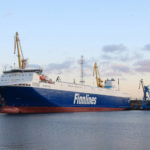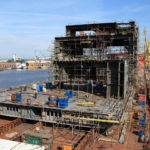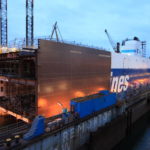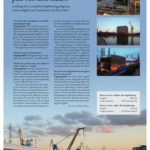RoPax shipping company Finnlines is working on a complex lengthening program. For HANSA, CFO Tom Pippingsköld provides some insights and comments on the project
What have been the single steps of the programme?
Tom Pippingsköld: In 2016, Finnlines initiated a study on lengthening[ds_preview] a ro-ro vessel. The technical specification including a concept study was prepared during autumn 2016. The study led to an order and more detailed plans were carried out in cooperation with Remontowa Shiprepair Yard.
The first ship arrived at yard for lengthening at the end of September 2017. By the end of May 2018, »Finnsun«, »Finnsky«, »Finntide« and »Finnwave« have already been lengthened and returned to service. Lengthening works for the final two vessels, »Finnbreeze« and »Finnsea« will be carried out between September and December 2018.
Each vessel was lengthened with an approximately 30m long insert, weighting some 1,500t each. A vessel was cut in two and a 30m section was inserted between the parts. The sections were welded together again, and around 1,000 additional lane metres were added to the vessel’s capacity.
How long did each lengthening take?
Pippingsköld: A major operation was carried out in a reasonably short time, which meant that each ship stayed at the yard less than two months.
What have been the biggest technical challenges – expected and unexpected?
Pippingsköld: Overall, everything went well. We have not faced any bigger technical issues. Of course, there have been minor challenges during the whole project that have been solved smoothly. All in all, we are very satisfied that this program has been a great success both technically and operationally.
Are there any »learning effects«?
Pippingsköld: We identified some key points which were reflecting positively to the program. Firstly, it is crucial to have a good site team at yard to follow up and inspect the project daily. Secondly, it is also important to have regular meetings with the yard’s project team.
What about the planned »better energy efficiency«?
Pippingsköld: Each lengthened vessel will have a significant capacity increase of around 30%. The capacity increase reduces the bunker consumption per transported cargo unit – the fuel consumption per transported tonne will decrease when considerably more cargo can be loaded onboard a ship. At the same time, emissions per transported tonne will decrease.
Have there been any effects on stability and maneuvering?
Pippingsköld: The vessel had a good stability before the lengthening and due to that the effect on the stability was small. The lengthened maneuverability is still good. The wind limit was only reduced by 1 m/s. The lengthened vessel has more waterline and therefore it is performing better in rough sea conditions than before – the longer ship takes the waves better.
Did the costs exceed the plans?
Pippingsköld: The lengthening was implemented as planned – also financially.
Would you go the same way again or rather order new vessels?
Pippingsköld: One key element of our strategy is to grow together with our customers and therefore we were responding to the growing demand by increasing vessels’ cargo capacity and lengthening is a very efficient way to do it.
The second key element of our strategy is to focus on improving our operational and financial performance in order to increase competitiveness and, as a result, to improve the efficiency of capital employed on our fleet. This 70mill. € investment is also in line with our third key element of our strategy, to continue investing in sustainable development: by further increasing our energy efficiency we will contribute to reduce emissions per transported tonne.
As we are continually investing in our fleet, over 1 bn € in the past twelve years, we have ordered three new environmentally friendly hybrid RoRo vessels. The total investment is over 200 mill. €. The first ships are set for delivery in 2020-2021.
The lengthening is a faster process than ordering new larger vessels, which will take two to three years. When our lengthening programme is complete, six vessels will have been lengthened, bringing online another 6.000 linear metres of rolling cargo: the equivalent of two sizeable vessels. As we see it, the one option does not preclude the other.
Have German shipyards been an option for the conversion?
Pippingsköld: We have been negotiating with several shipyards and one German shipyard was among these. We cannot give more details about the reasons for not choosing a German shipyard. Generally speaking, the shipyard needs to have specified technical and technological experience and know-how for the conversion. The past experience of Remontowa was decisive when choosing the supplier.
Interview: Michael Meyer




























